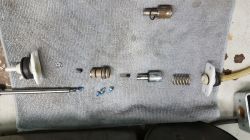FAQ
TL;DR: On Karcher Puzzi 10/1 pumps, 1/2‑wave AC drives the solenoid, and “These pumps die only when their winding burns.” If spray stops and the pump goes quiet, clean/regenerate the pump and verify the series diode. [Elektroda, Musiol, post #17318813]
Why it matters: This helps Puzzi 10/1 owners and techs quickly fix no‑spray issues without needless pump replacements.
Quick Facts
- Reported pump: Gotec EKS 17 TP/C, 230V 50Hz 40W (Article 114184). Always confirm on your unit’s label. [Elektroda, pershing1899, post #17318743]
- The pump runs on half‑wave via a series diode; burned diode = silent pump, missing diode = no pumping stroke. [Elektroda, Musiol, post #17318813]
- Typical fault: stuck piston or hanging valve; clean and reassemble in the exact order. [Elektroda, Musiol, post #17318395]
- Service “pump exchange” quoted around PLN 500, often with no repair/regeneration option. [Elektroda, pershing1899, post #17289220]
- Regeneration offers reported at about PLN 35, depending on provider. [Elektroda, pershing1899, post #17318784]
Why is my Puzzi 10/1 pump quiet and not spraying water?
A stuck piston, a hanging valve, or internal clogging can reduce stroke and mute the sound. Disassemble the pump head, clean each part, and refit in the correct sequence. “A standard fault” is exactly this mechanical hang‑up. Reassembly order is critical for flow. [Elektroda, Musiol, post #17318395]
What pump model and specs does the Puzzi 10/1 use?
One reported unit used a Gotec EKS 17 TP/C solenoid pump, 230V, 50Hz, 40W, Article 114184. Read your pump’s label to confirm the exact variant before ordering parts. The printed typeplate is the most reliable identifier. [Elektroda, pershing1899, post #17318743]
How do I clean and reassemble the pump correctly?
- Unplug mains, remove the pump module from the housing.
- Open the pump head; clean piston, spring, valves, and seats. Inspect O‑rings.
- Reassemble in the exact stack order; wrong order prevents suction and spray.
Reassembly sequence matters for correct valve operation. [Elektroda, Musiol, post #17318395]
How do I check the half‑wave diode in the pump circuit?
These pumps run on one half‑wave. Test the series diode with a meter. A burned (open) diode leaves the pump silent. A missing or shorted diode prevents a correct stroke, so it won’t pump. Replace the diode if faulty and re‑test. [Elektroda, Musiol, post #17318813]
Where is the diode located and what should I replace it with?
Check the pump’s power leads; some units have the diode in‑line on the cable or embedded in the housing. You can fit a standard shop diode in series on the pump supply; cost is about PLN 1. Verify the coil gets power as well. [Elektroda, Alek_H, post #17292572]
My diode keeps blowing—what’s the root cause?
A repeatedly failing diode points to a faulty pump coil. Replacing only the diode will fail again if the coil is compromised. Fix the underlying coil issue or replace/regenerate the pump to stop recurrent diode damage. [Elektroda, antek124, post #17296478]
How do I check for air leaks or suction issues before blaming the pump?
Inspect hoses, joints, and seals so the pump doesn’t pull air. Prime the intake and see if it draws water. Replace worn O‑rings and check for leaks at all fittings. A leaking suction side stops the pump from lifting liquid. [Elektroda, antek124, post #17289130]
Is regeneration a good fix versus replacement?
Yes. Regeneration means cleaning and replacing seals to restore stroke. “These pumps die only when their winding burns,” so mechanical refresh often revives them. This is cost‑effective when the coil is intact. Choose reputable service for seal quality. [Elektroda, Musiol, post #17318813]
How much does a service pump replacement cost?
A user reported a service quote of about PLN 500 for a straight pump exchange. Many service centers replace the pump rather than attempt repair or regeneration. Budget accordingly before authorizing work. [Elektroda, pershing1899, post #17289220]
How much does pump regeneration cost?
A regeneration offer was cited at roughly PLN 35. Prices vary by provider and scope, but this gives a ballpark for cleaning and seals. Confirm turnaround and warranty. [Elektroda, pershing1899, post #17318784]
Did regeneration actually solve the case in this thread?
Yes. After regeneration, the poster reported the pump returned and “everything works nicely.” This confirms that cleaning and resealing can restore spray when the coil is intact. [Elektroda, pershing1899, post #17334942]
Are there substitute pumps (e.g., Zelmer) that fit the Puzzi 10/1?
Gotec ETS/EKS variants appear in similar machines. One suggestion was ETS 17‑TP/B, but the advisor noted uncertainty. Remove your pump and read its exact typeplate before ordering any substitute. Model verification avoids mismatch. [Elektroda, antek124, post #17289300]
My pump still won’t draw water after cleaning—what next?
Replace wear parts. New O‑rings and even a piston can be required for suction. Without spares on hand, repeated teardowns waste time. If parts aren’t available, swap or professionally regenerate the pump assembly. [Elektroda, antek124, post #17318764]
Is the spray pump high‑pressure, and should I hear leaks?
No. It is not a 10‑bar pump, so small leaks may be inaudible. Visual inspection and disassembly work better than listening for pressure hiss in this case. [Elektroda, antek124, post #17289242]
Where can I see the pump internals or assembly order?
The thread shows the internal stack of parts after dismantling and stresses that order is important. Use that as a visual guide during reassembly to ensure valves seat correctly. [Elektroda, Musiol, post #17318395]
How do I confirm the coil is getting power?
Measure at the pump during the spray command. Check that the electromagnet is live and the circuit closes. If power is present but no pumping occurs, focus on the diode and mechanical internals. [Elektroda, Alek_H, post #17292572]




